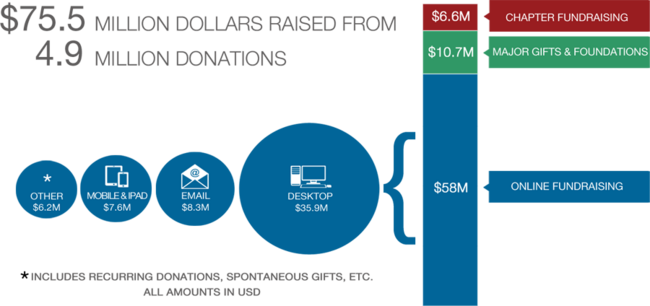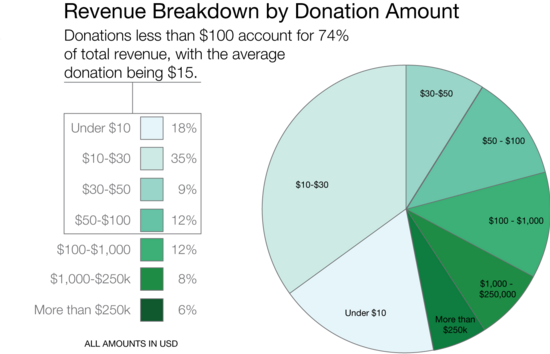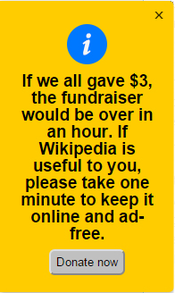Fundraising/2014-15 Report
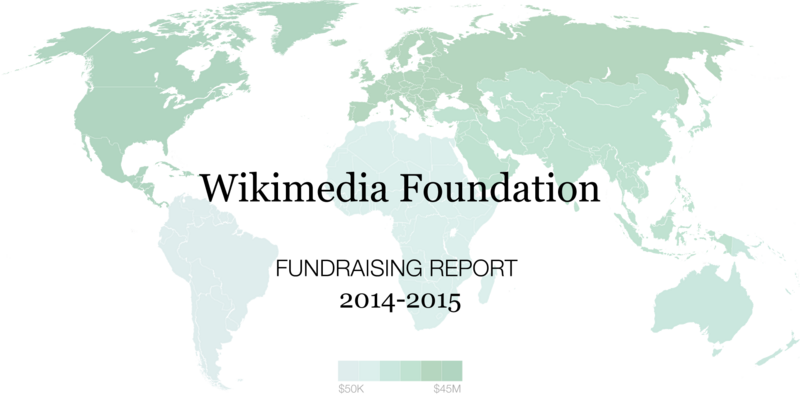
INTRODUCTION
[edit]More than 4 million donors around the world donated $75 million USD to make the Wikimedia Foundation's 2014–2015 fiscal year the most successful fundraising cycle in our history. This incredible demonstration of support, along with the continued contributions to Wikimedia content from tens of thousands of editors worldwide, ensures that Wikipedia and its sister sites remain vibrant, trusted archives of human knowledge, for the betterment of all.
We deeply appreciate the generosity of our community of volunteers, readers, and donors. Together we advance our mission by making more knowledge available for more people, building new communities of creators and learners, and making connections across disciplines, languages, and continents.
When Wikipedia was launched on January 15th, 2001, the internet was a very different place. From digital privacy to mobile-ready websites and apps, the support of our donors lays the foundation for us to learn, grow, and meet the enormous privilege and challenge of being the world's greatest online library.
We are happy to share some of what we learned in the last year of Wikimedia fundraising.
KEY STATS
[edit]
Readers around the world show their support for Wikipedia each year. The fundraising team strives to provide readers worldwide with the best localized donation experience possible by offering preferred local payment methods and high quality messages in various languages. In 2014-15, we expanded fundraising to readers in France and improved the donation experience for Hebrew, a right-to-left language. If you would like to help translate fundraising messages or provide localization feedback, please get involved here.


RESEARCH
[edit]Our team conducts a variety of research projects that inform our fundraising campaign design. In the last cycle, these projects included:
- Online user tests, where readers were observed interacting with our donation system to better understand reader behavior, identify potential issues, and highlight areas for improvement.
- A comprehensive reader survey, conducted by an independent research company.
- In-person sessions with existing donors to gain their perspective on Wikipedia and their motivations to contribute.
Research projects were performed in many countries to provide the best, most accurate local experience. Our research resulted in tangible improvements to our banner design and payment processing, and provided us with new messaging ideas and test concepts.

Throughout the year, online user tests were conducted by observing readers interacting directly with banners to improve the donation flow and quality of our messaging.
By observing users interacting with banners, various improvements were identified, including form spacing, button size, input fields, error messages, and scrolling behavior.
The parts of the fundraising message that users told us they liked most were the concepts of no advertising, keeping Wikipedia free, and being a non-profit. Many users did not know Wikipedia was a non-profit before seeing the fundraising message during the user test. Testers often reported wanting to donate after reading the fundraising message.
In February of 2015, the fundraising team engaged Lake Research Partners (LRP) to conduct a detailed survey of Wikimedia readers. Topics covered include recollection of and response towards Wikimedia fundraising messages, as well as general charitable habits and perceived value of Wikipedia.
Below are a sample of highlights from the survey.
From LRP: "Majorities of users in all countries surveyed say Wikipedia does not run fundraising messages very often, and are under the impression that Wikipedia asks for donations less than other nonprofit organizations. These are favorable impressions to maintain."


From LRP: "Users tend to rate both the large and small banners towards the middle of the subtle-intrusive scale; few users consider either banner to be either very subtle or very intrusive. On average, users rate the larger banner as slightly more intrusive than the smaller one, but, overall, their ratings vary little based on the size of the fundraising message."
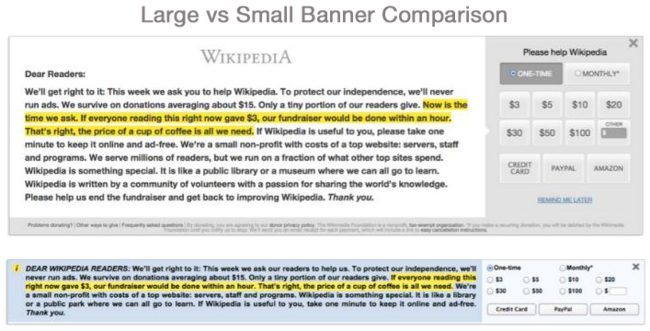
Throughout the year, the fundraising team conducts focus groups with readers and donors to learn about their Wikipedia usage habits and how to improve fundraising methods. It is it extremely valuable to hear from real users, in their own words, about the reasons they use and support Wikipedia, and their suggestions for making the reading and contributing experience even better.

TESTING
[edit]The majority of our current donors come in via fundraising banners placed on Wikipedia. The fundraising team relies on statistical analysis of donor and reader habits to design and execute banner campaigns. Each new fundraising concept is tested against our "Current Best" performing banner to determine its donation rate and average amount given. The most promising experiments are re-tested and refined so that the widest possible audience sees the best fundraising appeal.
The ideal fundraising banner fulfills three key requirements:
- Educates Wikipedia readers about our organizational mission
- Provides a convenient, fast, and clear donation process for readers worldwide
- Raises the budget to fund the Wikimedia movement while minimizing the disruption of the reader experience
In pursuit of these goals, we have built an internal testing system that allows us to easily segment and serve content to our hundreds of millions of readers.
In the last fiscal year, the fundraising team expanded our ability to customize the campaign experience for each reader. Previously, fundraising banners had a simple, sitewide on/off switch; when activated, all readers would see the same content. Improvements to our delivery platform in 2014 allowed us to target one large banner to each reader, followed by less obtrusive banners throughout the campaign.
We combined this advanced targeting with a new ability to limit the number of overall banners each reader saw. Two weeks into the campaign, we capped the maximum banners that an individual reader would see at five, ensuring that all readers had an opportunity to donate, without oversaturating frequent readers.
The end result: greater latitude with testing, a longer tail to catch infrequent visitors, and less disturbance of our consistent readers.



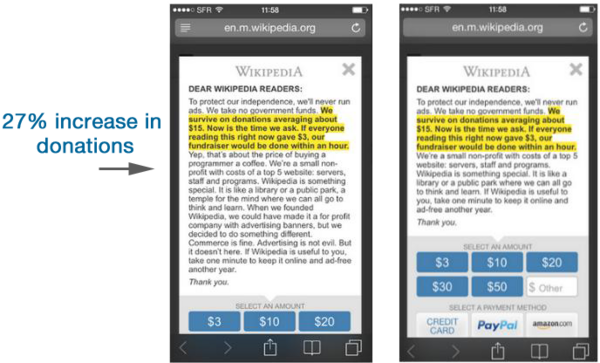

Wikimedia's email fundraising program has grown significantly in recent years. Readers submit their email address for future communications when they make a donation and a year later the fundraising team sends an annual reminder to donate. We value our donors and respect their inboxes. We don't send frequent emails; instead we send a very occasional update on Wikimedia news and only ask for a donation once a year. Similar to banner testing, we also test different variations of the email to find the best ways to communicate with donors. As our community of donors continues to grow over the next years, our email fundraising program will continue to grow as well.

|

MAJOR GIFTS
[edit]
Major Gifts revenue grew steadily over the previous year. Major donors, both individuals and institutions, make donations of $1,000 or more in support of our mission. Their gifts include general operating grants and restricted gifts that support specific programs, such as the Wikipedia Zero team and the Global Education Program. Many of our donors choose to be recognized for their contributions on our Benefactors page.
In 2014, the Wikimedia Foundation received the largest single gift in our history, a $5 million unrestricted donation from an anonymous donor that will support $1 million worth of expenses per year, for the next five years. Large donations, like this gift, help us diversify our revenue stream and give high-capacity donors the opportunity to make a significant positive impact on our mission.
Major donations are received throughout the year, with a large number of these gifts arriving via a hybrid email/postal mail annual appeal campaign that runs in conjunction with the fundraising banners. We also host a small number of in-person fundraising events throughout the year.
FEEDBACK
[edit]During the 2014 English fundraiser, more than 270,000 donors — approximately 1 in 10 — completed a post-donation survey designed by the fundraising team. Survey feedback provided critical insight into the minds of our donors, helping us identify new fundraising approaches and make improvements to our existing systems.
Below are a few responses from the survey.
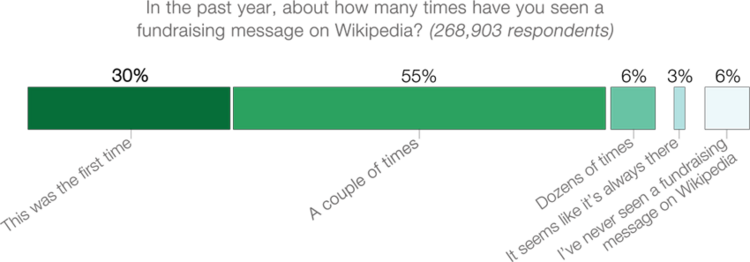

Nearly 50,000 online donors indicated that they would like to receive information about how to edit Wikipedia, and will be recontacted in the 2015–2016 fiscal year.
Throughout the year, the donor services team received nearly 60,000 emails from readers and donors, with the bulk of emails received during live campaigns. Readers receive a human response from our donor services and technical support team. Email communication with our readers and donors is a great way to build relationships, understand user trends, and improve our fundraising results. The most common incoming emails were compliments on our work, and questions about payment processing and the donation flow.
Yours is by far the best non-profit idea and organization on the planet today. I'm also glad you raise money in nickels and dimes as opposed to fifty big chunks from fifty well-heeled donors. It builds buy-in.
I am a physician from Israel. I know you get this response all the time but I feel I have to tell you: Wikipedia is part of my daily medical practice. I turn to it whenever I need to learn something fast about a drug or a disease. It helps me help my patients. Thank you!
Having Wikipedia on my phone is a great experience. On numerous occasions it has informed and enhanced discussions I've had with other people. Learning is amazing and Wikipedia fuels learning.
Thank you so much Lila and your colleagues at Wikimedia – the access for us, the global grassroots, to this wonderful encyclopedia is transforming our world for the better in so many fundamental ways. I have just realised from writing this email, for me personally, it has also somehow helped me to feel I am part of a tribe of people around the world, connected like a village through our mutual use of Wikipedia – that people across the globe are more approachable and human. The fact you are independent and are not affected by ads means a lot, and makes the knowledge you disseminate so much more trustworthy.
When I need an answer - I go to Wikipedia.
READERSHIP PROJECTIONS
[edit]Wikipedia is constantly changing, and the way people use it is also changing. The past five years has seen a marked rise in mobile readership and a corresponding decline in desktop usage. The Wikimedia analytics team forecasts that by December 2015 the annual pageview growth rate in the US will be down 27% on desktop, up 25% for mobile, and down 5% for overall pageviews.
In a handful of key fundraising countries, the rise of mobile does not offset the decline of desktop. This poses a great challenge for our fundraising, as we rely on a wide donor base to raise the budget. Although mobile readership has opened up a new donation channel to optimize, readers are historically less likely to donate while browsing Wikipedia on a mobile device.
UP NEXT
[edit]The fundraising team carefully follows our readership trends. Wikipedia is always evolving, and our priorities evolve to stay in alignment with the needs and interests of our readers.
As our mobile traffic increases, the fundraising team continues to expand our mobile fundraising campaigns. We have made great progress in the past year and will continue to focus on optimizing mobile fundraising as we go forward. The fundraising email program is also growing and will continue to innovate in the coming years. We will research and implement new methods to better serve readers worldwide, on desktop, mobile, in-app and through alternative channels.
One thing remains constant: new breakthroughs must be discovered to meet our goals. We will rely on our proven process to improve the effectiveness of our annual campaigns while innovating to find new revenue streams.
Thank you to our hundreds of millions of readers, more than four million donors, tens of thousands of volunteers, Wikimedia staff and the fundraising team for an incredible year.



